Imagine a marine agronomy that produces seaweed biomass

What should we expect from marine aquaculture in the future? Will it serve simply to top up the supply of seafood from capture fisheries, as is mostly assumed in projections about aquaculture and as illustrated in Fig. 1, or does it promise something more?
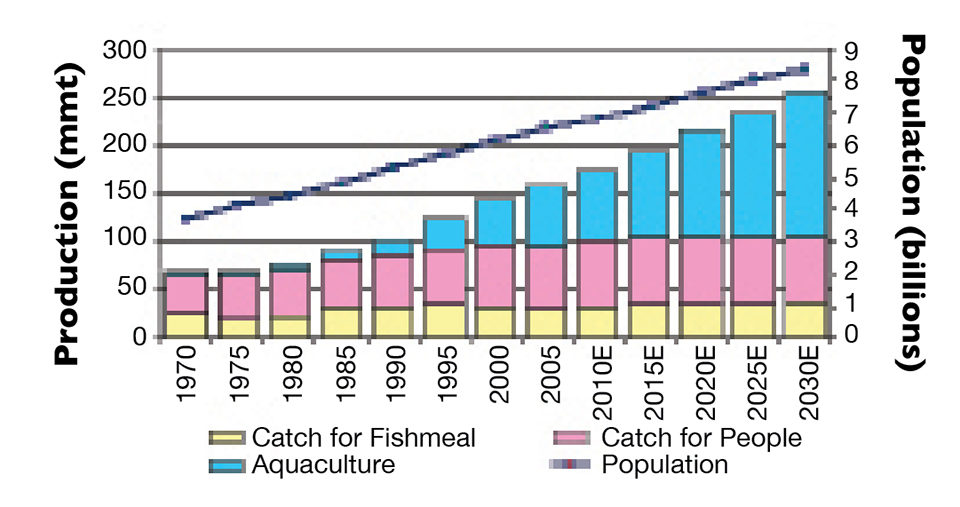
We have learned a great deal about how to farm in the sea in the last 40 years. Has this been a journey that will lead to little more than making more seafood available for mostly already well-fed people? Or can we turn to the sea and ask more of it by developing a marine agronomy that, one day, will contribute vital new resources to human needs?
Necessarily, most discussion about aquaculture development and the policies that guide it is about local issues of conservation, resource allocation and economics. Rarely do policy makers have the time or encouragement to stand back to look at the Earth and its people as one and imagine what ocean aquaculture might accomplish and look like 100 years from now.
It would be helpful to do so, because marine aquaculture’s journey so far, though short, has accomplished much. There is a need to build on this and offer a long-range vision for the industry that will help people understand its possibilities, put new ideas for development in context, and provide scope and direction for programs designed to test them.
Feeding humanity
A 2009 paper published in BioScience by Jorge Duarte and co-authors asked, “Will the oceans help feed humanity?” They pointed out that there will be 9.2 billion humans on Earth by 2050, and there is no certainty we can produce enough food for them by traditional agriculture. Availability of freshwater and land will constrain agricultural growth and, as people in developing countries become richer and eat more meat, demands on both freshwater and land will increase.
Further, these precious resources are being used increasingly to grow non-food crops such as cotton or for biofuel. From where will the extra food we need decades from now come? Might there be no other choice than to turn to the sea?
The oceans cover 70 percent of Earth and contain 97 percent of its water, yet they yield remarkably little of our food. Of the 7.1 billion metric tons (MT) of food harvested and eaten by humans each year, capture fisheries produce about 83 million MT, while marine aquaculture produces almost 36 million MT – about 1.2 and 0.5 percent by weight, respectively, of the total food supply.
In terms of yield/ha/year, we produce 1,251 Kcal and 32 g of protein from the land and 4 Kcal and 0.5 g of protein from the sea. Why do the oceans yield so little for us compared to the land, and can we find ways to make them more productive?
Lower trophic level
One reason for the present low productivity is that capture fisheries harvest mostly ocean predators that live high in the food web. At the average trophic level for world fisheries of 3.1 reported by Daniel Pauly and co-authors in Science in 1998, the 83 million MT caught annually in these fisheries originate from over 10 billion MT of marine primary production. By comparison, on land we farm, harvest and eat mostly primary products (plants), while the animals we grow are fed plant materials (Fig. 2). Put another way, terrestrial farm animals are produced in one trophic conversion step or at a trophic level of 2.0.
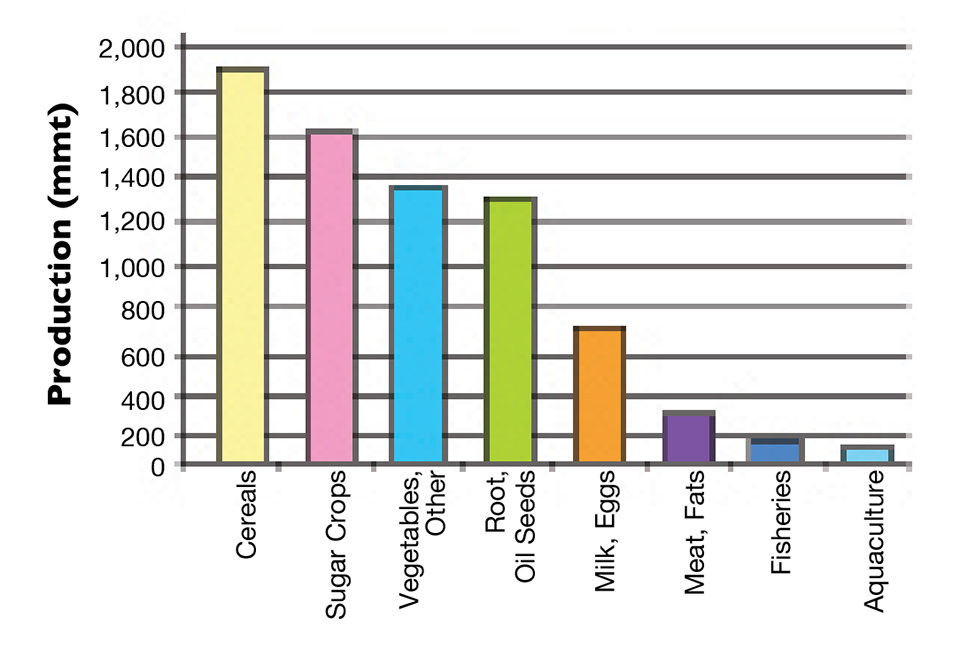
By growing seaweed and bivalve shellfish, marine aquaculture improves on capture fisheries simply by producing crops at lower trophic levels. However, it is also learning to reduce the trophic level of some of the most valuable crops it grows, namely certain species of fish and crustaceans.
Like farm animals on land, these animals have to be fed, but up to now their feeds have contained mostly fishmeal and fish oil, which, because they originate from wild-caught fish, means there is little or no trophic gain when they are fed to aquatic farm animals. However, by using ingredients derived from plants or microbial sources as replacements for fishmeal and fish oil in feeds, the natural food web can, in effect, be “shortcut,” and the trophic levels of these aquatic farm animals can be lowered.
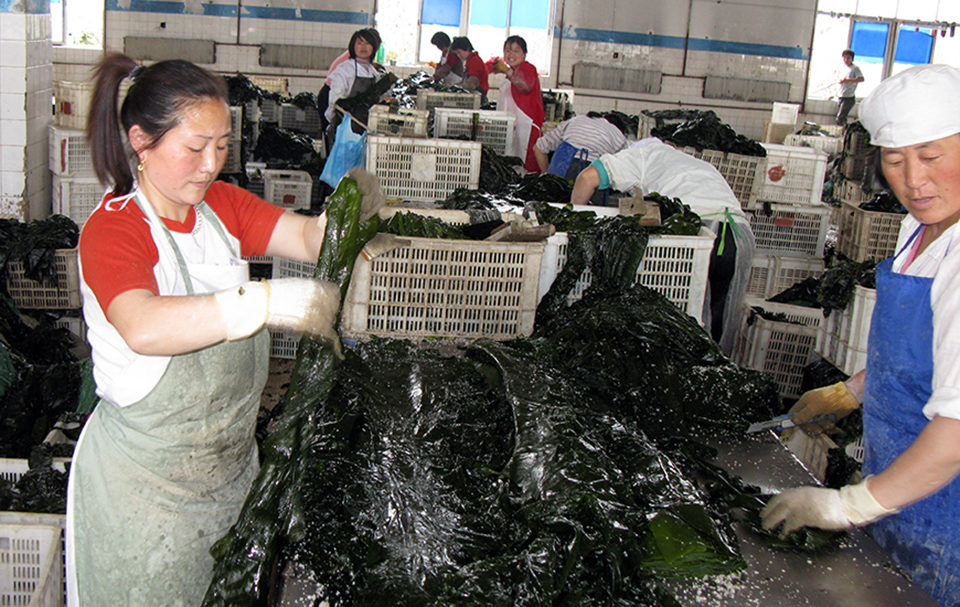
Ingredients from seaweeds
This leads to the question that if some marine fish can be fed on ingredients made from plants grown on land, why could they not be fed on ingredients made from plants like seaweed grown in the sea? Marine aquaculture already produces 14.8 million MT of seaweed annually, about half of which is eaten directly by people and half is processed, mostly to produce hydrocolloids used in processed foods.
Other products are extracted from seaweeds, too, including medically bioactive compounds and minerals. Seaweeds also contain valuable fats, including omega-3 and omega-6 polyunsaturated fatty acids, and protein. As referenced in a 2009 Fisheries Science article by Alok Kalla and co-authors, protein extract-ed from the seaweed Porphyra has been tested successfully as a feed ingredient for red seabream in Japan.
Why can we not imagine a marine agronomy that produces seaweed biomass as its primary crop to be converted in “biorefineries” into products for humans and animals, just like agricultural crops are used now?
Of course, imagining it is one thing, making it happen is another. That is why development of the marine aquaculture industry over the last 40 years has been so important. It has provided a foundation that has inspired invention and platforms on which new ideas have been tested. It must continue to be encouraged, to be allowed to learn by trial and error, to adapt to new commercial and ecological selective pressures, and to fail if the pressures become too great.
Then, if there is merit in the idea of a larger and more productive marine agronomy, new technologies and new industry structures will evolve. That this must be done in the full glare of 21st-century media and non-governmental organization scrutiny, and in a political climate where there is less and less tolerance for error makes it doubly difficult, but it is unlikely to happen in any other way.
Seaweed productivity
Productivity in seaweed farms can be quite high. Chinese production of Laminaria, for example, averaged 19.4 mt dry weight/ha in 2004. At this level, it would require only 0.9 percent of Earth’s ocean surface to produce a dry weight of seaweed equal to the 6.1 billion mt wet weight of food from plants produced annually by terrestrial agriculture.
Of course, extrapolations can mislead, and development on this scale, even if it was possible, would likely take many decades. But the idea that it might be possible to double our production of plant biomass for food by farming less than 1 percent of the ocean’s surface suggests that we are a long way yet from overwhelming Earth’s capacity to feed us and that we might be able to look to the sea to provide more. That this might be done without using more land or freshwater in a world getting short of both suggests that the need to test the idea is urgent.
This is not a new idea. In 1968, Howard Wilcox proposed that America should create “food and energy farms” by growing seaweeds in the nation’s coastal waters. Given impetus by the first world oil crisis of the 1970s, it became mostly a bioenergy project funded by the U.S. Department of Energy. The program eventually faded out as oil flowed freely again in the 1980s, and a sense of crisis lapsed into complacency.
Thirty years later, the world confronts energy and food challenges anew. Maybe the idea should be looked at again.
Though marine aquaculture has made major advances in the intervening years, it is still mostly managed alongside capture fisheries within narrow policy boundaries and is seen mainly as a way to supplement wild-caught seafood – or as a competitor to it – rather than as a possible solution to future global food shortages. A bigger vision and more expansive policy might prompt wider public understanding and appreciation of its importance.
(Editor’s Note: This article was originally published in the September/October 2010 print edition of the Global Aquaculture Advocate.)
Now that you've reached the end of the article ...
… please consider supporting GSA’s mission to advance responsible seafood practices through education, advocacy and third-party assurances. The Advocate aims to document the evolution of responsible seafood practices and share the expansive knowledge of our vast network of contributors.
By becoming a Global Seafood Alliance member, you’re ensuring that all of the pre-competitive work we do through member benefits, resources and events can continue. Individual membership costs just $50 a year.
Not a GSA member? Join us.
Author
-
Dr. John Forster
Forster Consulting Inc.
533 East Park Avenue
Port Angeles, Washington 98362-6937 USA
Tagged With
Related Posts

Responsibility
A look at integrated multi-trophic aquaculture
In integrated multi-trophic aquaculture, farmers combine the cultivation of fed species such as finfish or shrimp with extractive seaweeds, aquatic plants and shellfish and other invertebrates that recapture organic and inorganic particulate nutrients for their growth.

Responsibility
A look at various intensive shrimp farming systems in Asia
The impact of diseases led some Asian shrimp farming countries to develop biofloc and recirculation aquaculture system (RAS) production technologies. Treating incoming water for culture operations and wastewater treatment are biosecurity measures for disease prevention and control.
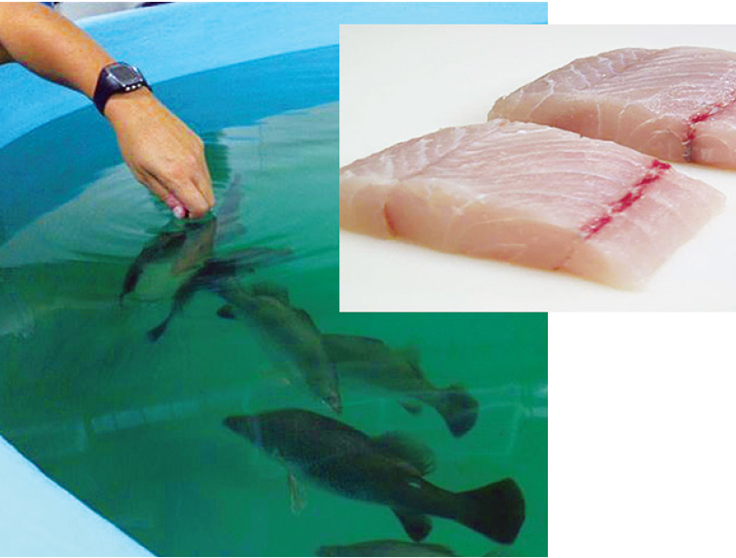
Intelligence
Adding flavor complexity to farmed barramundi
Organoleptic attributes such as flavor and aroma are among the most important factors that influence consumer acceptability and demand for fish products. Consumers have identified farmed fish as less complex and lacking “sealike” or “sea-fresh” flavors and aromas.
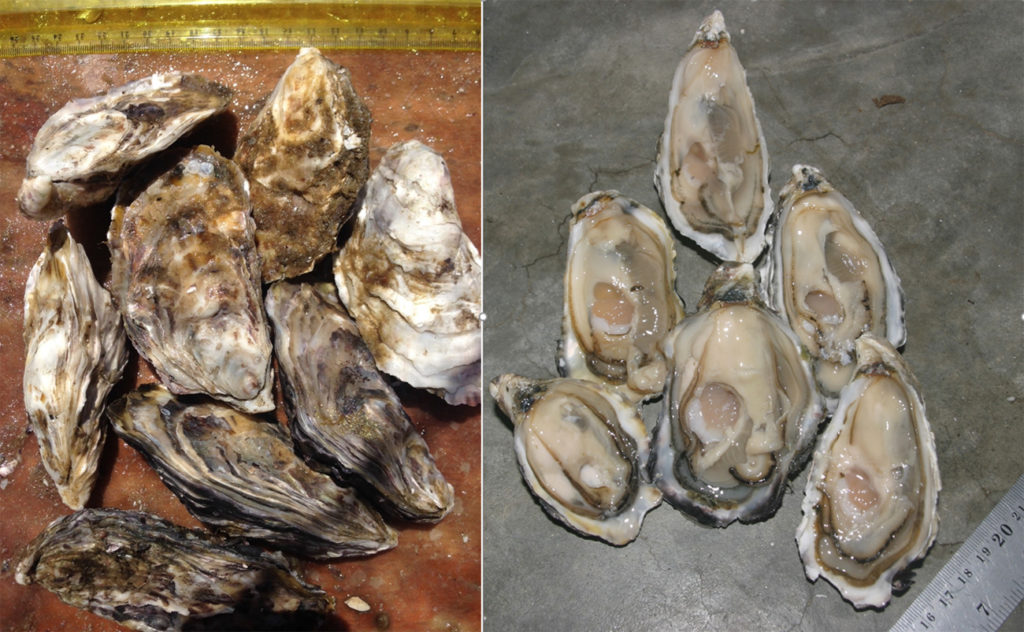
Intelligence
An emerging shellfish farming industry in Namibia
For shellfish farming in Namibia to continue expanding, industry must better comply with approved sanitation standards. The Namibian Shellfish Monitoring and Sanitation Program, currently in development, will help.


